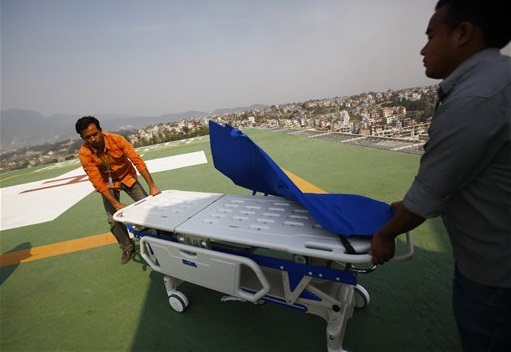
Hospital staff get ready to receive the injured from an avalanche, on helipad of Grandy hospital, in Katmandu, Nepal, Friday, April 18, 2014. An avalanche swept down a climbing route on Mount Everest early Friday, killing at least 12 Nepalese guides and leaving three missing in the deadliest disaster on the world’s highest peak. AP
KATMANDU, Nepal — Rescuers were digging through piles of snow and ice Saturday for four Sherpa guides buried on Mount Everest when an avalanche swept down the slopes and killed 12 other Nepalese guides in the deadliest disaster on the world’s highest peak.
Seven of the 12 bodies pulled out and brought down Friday have been handed over to their families in the Everest region, while the other five were taken to Katmandu.
The avalanche barreled down a narrow climbing pass known as the “popcorn field” for its bulging chunks of ice at about 6:30 a.m. Friday. At the time, the group of Sherpa guides had been making their way up to the higher camps to fix ropes and dig a path for foreign clients ahead of next month’s peak season.
One of the survivors told his relatives the path up the mountain had been unstable just before the snow slide hit at an elevation near 19,000 feet (5,800 meters). As soon as it occurred, rescuers, guides and climbers rushed to help.
The area is considered particularly dangerous due to its steep slope and deep crevasses that cut through the snow and ice covering the pass year round.
Searchers were trying to work quickly on Saturday in case weather conditions deteriorated, Tourism Ministry official Krishna Lamsal said at the mountain’s base camp. But the painstaking effort to navigate the unstable field involved testing the strength of the newly fallen snow and using extra ropes, clamps and aluminum ladders.
Four survivors were conscious and being treated in the intensive care units of several Katmandu hospitals for broken ribs, fractured limbs, punctured lungs and skin abrasions, according to Dr. C.R. Pandey from Grande Hospital. Others with less serious injuries were treated at base camp.
The avalanche struck just as hundreds of climbers, guides and support crews were at Everest’s base camp preparing to climb the 29,035-foot (8,850-meter) peak early next month, when weather conditions are most favorable. The Sherpa guides had been setting up camps at higher altitudes, and fixing routes and ropes on slopes above.
One of the injured guides, Dawa Tashi, said the Sherpa had woken up early and were on their way to fix ropes, but were delayed because of the unsteady path. Suddenly, mounds of snow tumbled down on the group and buried many of them, according to Tashi’s sister-in-law, Dawa Yanju. Doctors said Tashi had suffered several broken ribs.
The Sherpa people are one of the main ethnic groups in Nepal’s alpine region, and many make their living as climbing guides on Everest and other Himalayan peaks.
More than 4,000 climbers have summited Everest since 1953, when it was first conquered by New Zealander Edmund Hillary and Sherpa Tenzing Norgay. Hundreds have died trying.
The worst recorded disaster on Everest had been a fierce blizzard on May 11, 1996, that caused the deaths of eight climbers, including famed mountaineer Rob Hall, and was later memorialized in a book, “Into Thin Air,” by Jon Krakauer. Six Nepalese guides were killed in an avalanche in 1970.
Earlier this year, Nepal announced several steps to better manage the heavy flow of climbers and speed up rescue operations. The steps included the dispatch of officials and security personnel to the base camp at 17,380 feet (5,300 meters), where they will stay throughout the spring climbing season that ends in May.